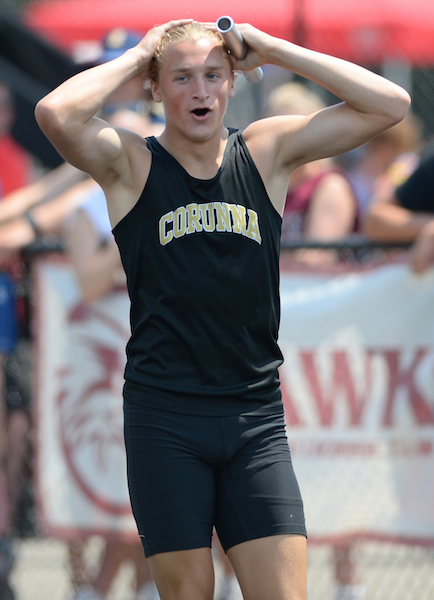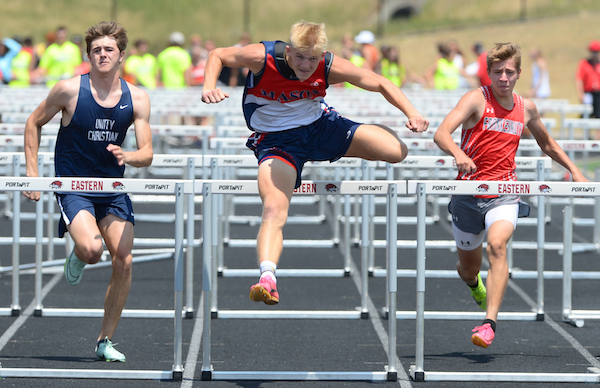
Concord Conquers LP D4 Convincingly
May 31, 2014
By Chip Mundy
Special to Second Half
HUDSONVILLE – Concord distance runner Jesse Hersha imagined the Yellow Jackets would win the MHSAA Lower Peninsula Division 4 track and field championship as far back as last summer.
Or just about the time he heard that Nolen Bright-Mitchell was coming to Concord from Albion High School, which had closed its doors because of budget issues.
“Last spring, we were already thinking we were going to be really good and we had a shot to win the state title,” Hersha said. “Later that summer, I heard a rumor that Nolen was coming, but they were trying to keep it on the down low.
“I asked my dad - he’s the coach - and he just said, ‘He is.’ I was like, ‘Yea, we’re going to win the state title.’ ”
Concord did it convincingly, too. The Yellow Jackets finished with 78 points, far ahead of the 46 registered by defending champion and runner-up Saugatuck.
Bright-Mitchell was as good Saturday as Hersha was with his premonition last summer. After winning the 200 last year for Albion, Bright-Mitchell swept the 100 and 200 and ran on Concord’s winning relay teams in the 800 and 1,600. He set LP Division 4 records in the 100 (10.7 seconds) and 200 (21.62), and the 1,600 relay also set an LP Division 4 record in 3 minutes, 24.19 seconds.
Bright-Mitchell, wearing a blue shoe on his left foot and an orange one on his right, will attend Grand Valley State University in the fall. But he hasn’t forgotten his Albion roots.
“I wore my Albion warm-ups in every meet we had,” he said. “But I love Concord. It’s a great community with great teachers and a great school.”
It was the second MHSAA championship in five years for Concord, which won the 2010 title.
“It’s been a really good year, and we accomplished a lot,” Concord coach Mark Hersha said. “We had a vision for it at the beginning of the year, and it’s really good to see the guys put it all together.”
Coach Hersha also received a bonus as he watched his son Jesse win his first individual track title as he took the 3,200 in 9:38.54.
“That was kind of nice, too,” Mark Hersha said. “It was a fast 1,600, so it was disappointing he was third. He cooled down a little bit, and it was courageous to go back out there and run again in the 3,200.”
Jesse Hersha, just a sophomore, already is a two-time individual champion in cross country.
“My whole high school career has kind of been like an only-distance track team, but now we’ve had a lot more people to come out from the baseball team and everything,” he said, “and a couple of Albion guys, especially Nolen.
“You have to give a lot of credit to Nolen for winning four events.”
Bright-Mitchell had some help on the relays as was joined on the winning 1,600 relay team by Lonelle Langston, Chase Hinkle and Zach Hudson, another Albion transfer.
The winning 800 relay team also included Brett Lehman, Langston and Chevy Burk. Langston also was seventh in the high jump, Lehman was eighth in the 100 and Burk was 11th in the long jump.
Concord also placed fourth in the 400 as Lehman, Hinkle, Treyvon Miller and Langston finished in 44.77 seconds.
Another Albion connection is on the coaching staff as former Albion coach Mike Jurasek and his assistant Dan Davis serve as volunteer coaches. Jurasek is a Concord graduate, and Coach Hersha welcomed him to the staff.
“From a distance, we’ve all seen the success he’s had at Albion and stuff like that,” Hersha said. “It’s kind of almost a miracle to see the things he does with kids – his personality, the way he prepares himself to prepare them – again, there’s a reason why he’s successful.
“Everything about him is a model of excellence, and it’s been a blessing all year long to have him. He doesn’t only help with the guys but with the girls, too.”
Saugatuck had only one individual champion, but it came with some flash. Freshman Blake Dunn won the 300 hurdles in 40.22 seconds, while David Dykstra of White Cloud took the 110 hurdles.
There were two LP Division 4 state records broken in the field events. Curtis Bell cleared 15 feet, 1 inch to set a record and win the pole vault, while Tyrell Hall of Marion soared 12-11.75 to win the long jump.
Other winners in the field events were Tucker Scharf of Unionville-Sebewaing in the discus (148-6), Tyler Crenshaw of Brown City in the shot put (51-8), and Hunter Weeks of Homer in the high jump (6-7).
In the running events, Austin Sandusky of Morenci won the 400 in 50.48, Bryce DeGrammont of Mio took the 800 in 1:58.09, and Luke Anderson of Harbor Beach captured the 1,600 in 4:17.49. The 400 relay went to Southfield Christian, and Muskegon Western Michigan Christian took the 3,200 relay.
PHOTO: Concord’s Nolen Bright-Mitchell (4) set LP Division 4 Finals records in both the 100 and 200 Saturday in Hudsonville. (Click to see more from RunMichigan.com.)

Vicksburg's Wright, Corunna Right On in Claiming LPD2 Championships
By
Steve Vedder
Special for MHSAA.com
June 3, 2023
ADA – If Michael Wright was a baseball player, he probably would've been called out on strikes a year ago.
Instead, the Vicksburg senior can celebrate after winning the 200 at Saturday's Lower Peninsula Division 2 Track & Field Finals at Forest Hills Eastern.
The road to the championship in the 200, via a time of 21.72, was anything but a straight line for Wright. An aspiring baseball player, he was cut from the Vicksburg squad as a freshman. His football career, by Wright's own admission, was "on and off." And then a year ago in his first track meet, Wright suffered a leg injury that virtually ended his season. He did return to finish fifth in the 200 at Finals while helping the 400 relay team to a 16th place.
So there is nothing to realistically explain how Wright found himself in the position Saturday at sweltering Forest Hills Eastern to win a championship. Except for returning this season to break the school record in the 200 four times in two months. Well, that and willpower and simple desire.
 "I knew I could finish high, maybe in the top five. But this is better," said Wright, who credits drinking large quantities of milk for his resurgence. "I looked to football because I didn't think I could bounce back for track. But I overcame the bumps, the obstacles."
"I knew I could finish high, maybe in the top five. But this is better," said Wright, who credits drinking large quantities of milk for his resurgence. "I looked to football because I didn't think I could bounce back for track. But I overcame the bumps, the obstacles."
While Wright was jump-starting his track career, Corunna won the team title with 41 points. Mason and Forest Hills Eastern tied for second with 35. Whitehall was fourth with 33 points, and Frankenmuth fifth with 29 points.
Corunna coach Jeff Sawyer, who had never won a Finals title in 37 years coaching at Owosso and three more at Corunna, said the championship came after little fanfare during the season. Virtually right up until the time Corunna hauled off its first-place trophy, Sawyer said it was never really on his team's mind. The title came after the team managed only a runner-up finish at the Regional.
"We kind of low-keyed it," he said. "We knew scoring 40 points was possible. We lost to Frankenmuth by one point at the Regional. … We were a little disappointed we didn't win, but we had some good times today. We knew it was possible.
"Every day we just come and do what we do. We talk about getting better every day with PRs (personal records). And we're still getting better because we have some tough guys. Just competitive, tough kids. But we were the underdogs."
Corunna had only two firsts on Saturday, in the 400 relay (42.63) and Wyatt Bower in the long jump (22-8½).
Among the individual highlights was Frankenmuth senior Dalton DeBeau, who successfully defended his Finals title in the discus (171-6). He was fifth in that event as a sophomore and after winning a year ago, was considered a good bet to repeat.
"I kind of expected it," said DeBeau, who will compete at Michigan State next spring. "There wasn't a lot of pressure. I knew what had to be done. I threw 160 feet on my first throw to get in the finals, and that helped right away. I knew I could go all out."
 Berrien Springs' Jake Machiniak won the 100 (10.54) while the team also captured the 800 relay (1:28.18). Machiniak said his season hasn't been without its share of difficulties. There was a time when he couldn't seem to come out of the starting blocks smoothly. But beginning with the conference meet where he ran school record 10:73, Machiniak felt himself back on course.
Berrien Springs' Jake Machiniak won the 100 (10.54) while the team also captured the 800 relay (1:28.18). Machiniak said his season hasn't been without its share of difficulties. There was a time when he couldn't seem to come out of the starting blocks smoothly. But beginning with the conference meet where he ran school record 10:73, Machiniak felt himself back on course.
"There were ups and downs. I struggled in the middle of the season," he said. "But my teammates helped me through some difficulties. I came here to finish the job; I knew I could do something here."
Mason's Tyler Baker won the 100 hurdles (14.63) to complete a long journey that included finishing just ninth in last year's prelims. The success was as simple as putting in loads of offseason work.
"I practiced and did stuff about every day," he said. "I might not be the fastest, but I make up for that in form. It's a fine-tuning thing. Everyone wants to be faster."
Mason also got a championship from A.J. Mantel, who captured the 300 hurdles (38.90).
Among other highlights was Forest Hills Eastern senior Aiden Sullivan successfully defending a 2022 title on his own home turf. He won Saturday's 800 (1:53.92).
Adrian won the 3,200 relay (7:39.77), while Grand Rapids Christian took the 1,600 (3:24.49).
Alma had two individual winners in Michael Howey in the shot (55-08) and Jacob Dunlap in the high jump (6-7).
The other champs were Kyle Eberhard of Linden in the 1,600 (4:14.79), Whitehall's Trannon Ayler in the 400 (48.83), Freeland's T.J. Hansen in the 3,200 (9:11.56) and Sam Vesperman of Grosse Ile in the pole vault (15.01). Chelsea senior Jacob Nelson competed in the adaptive 100 (27.28), 200 (57.71) and shot put (6-6).
PHOTOS (Top) Vicksburg's Michael Wright celebrates after winning the 200 on Saturday. (Middle) Corunna's Tarick Bower enjoys a moment after anchoring the winning 400 relay. (Below) Mason's Tyler Baker, center, works to stay ahead in the 110 hurdles. (Photos by Dave McCauley/RunMichigan.com.)

